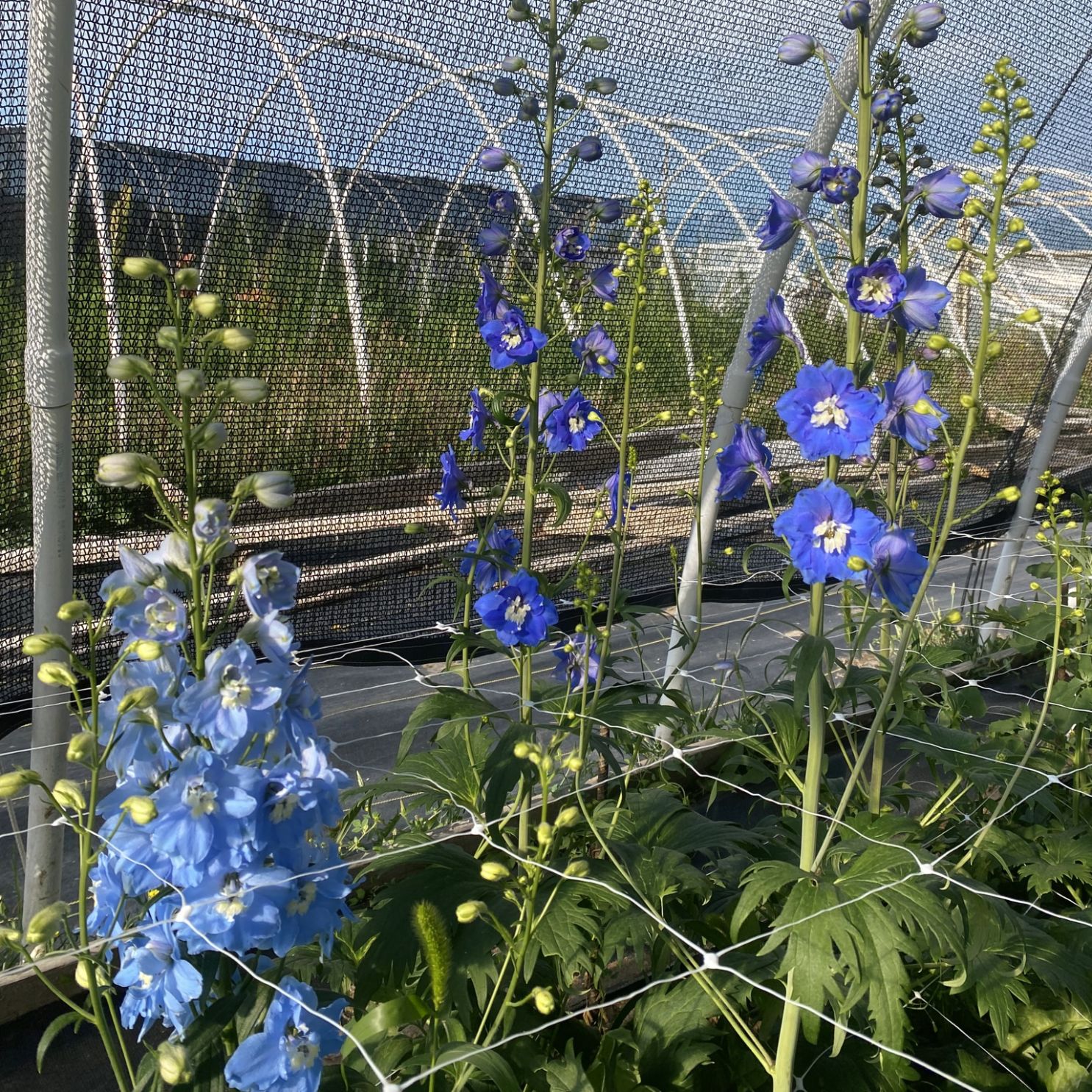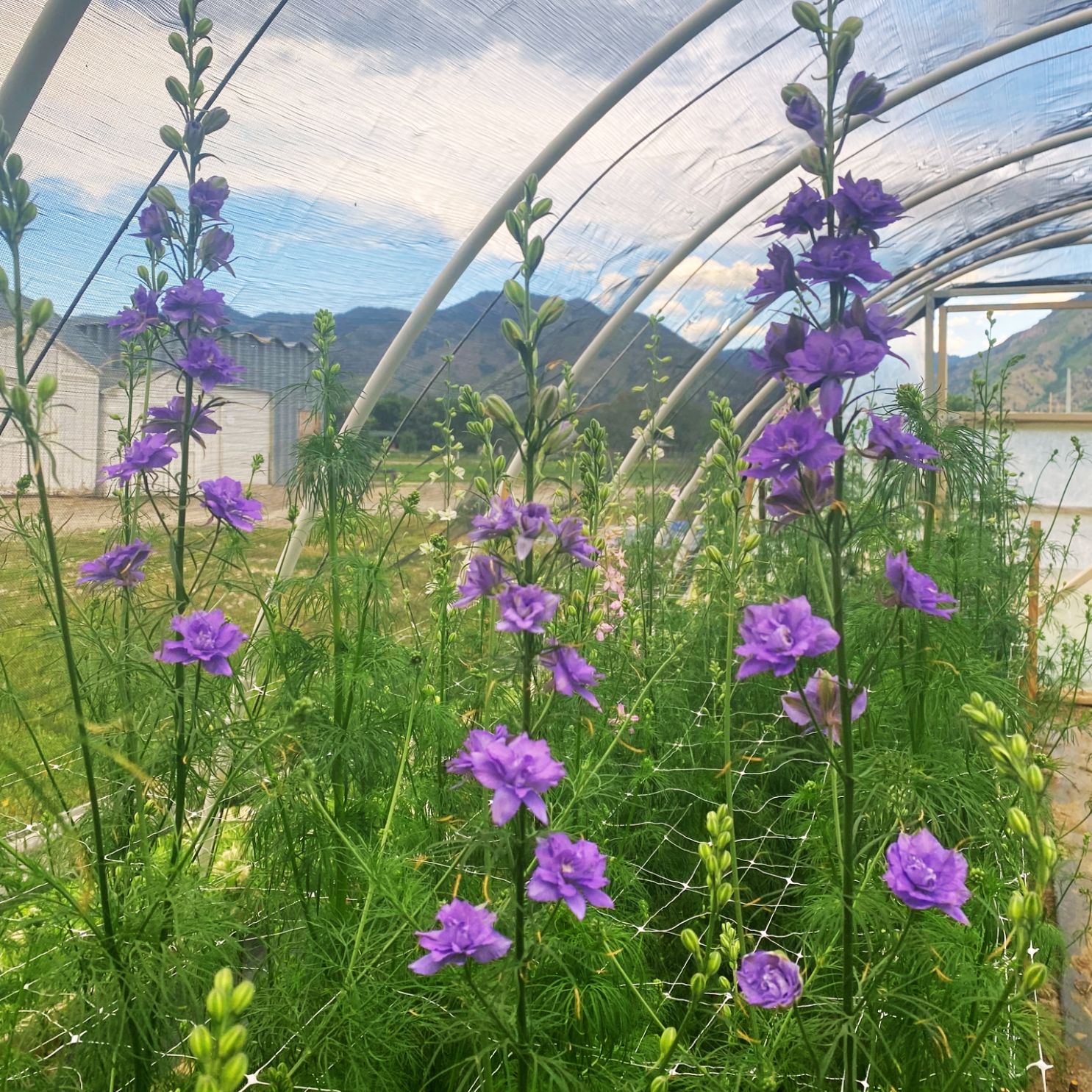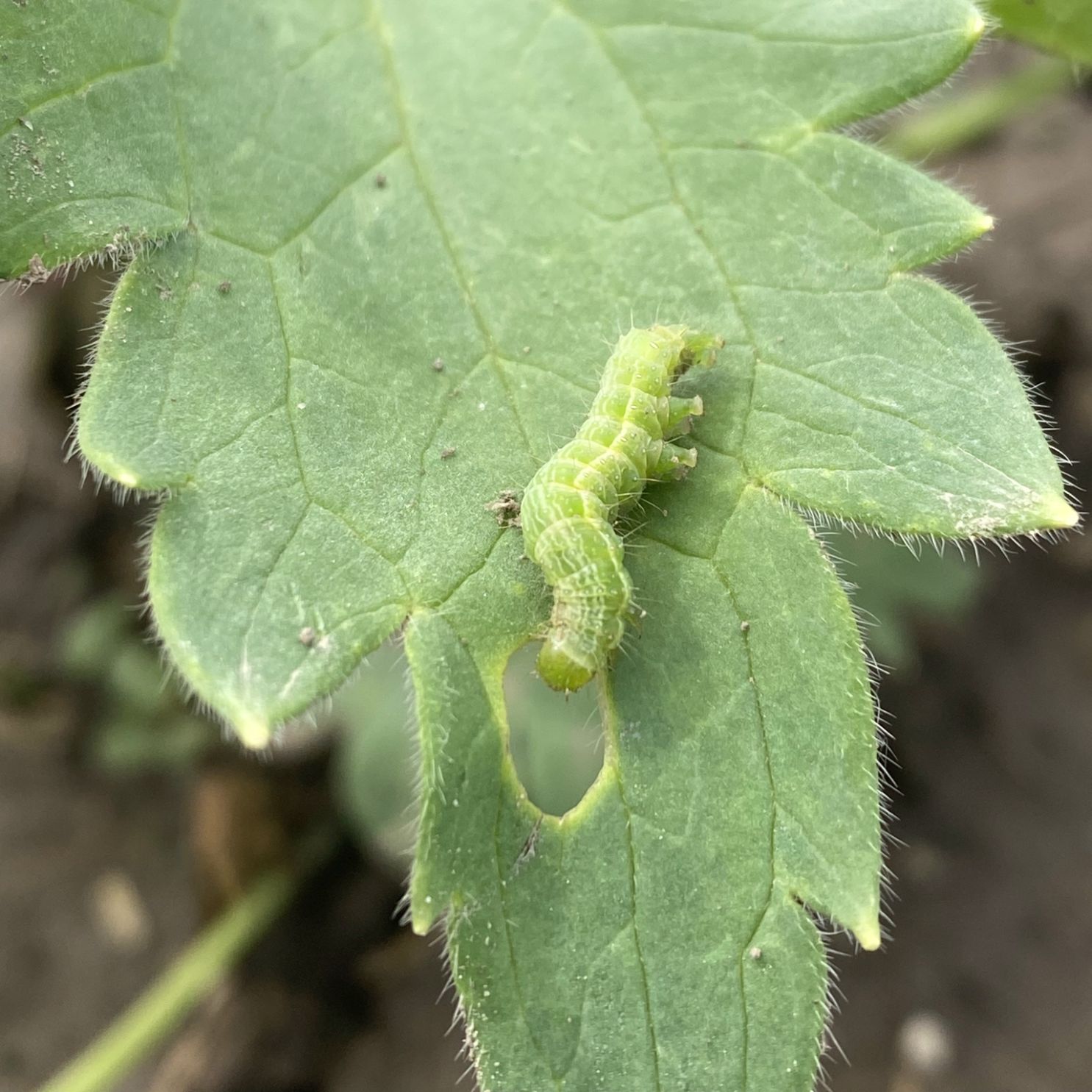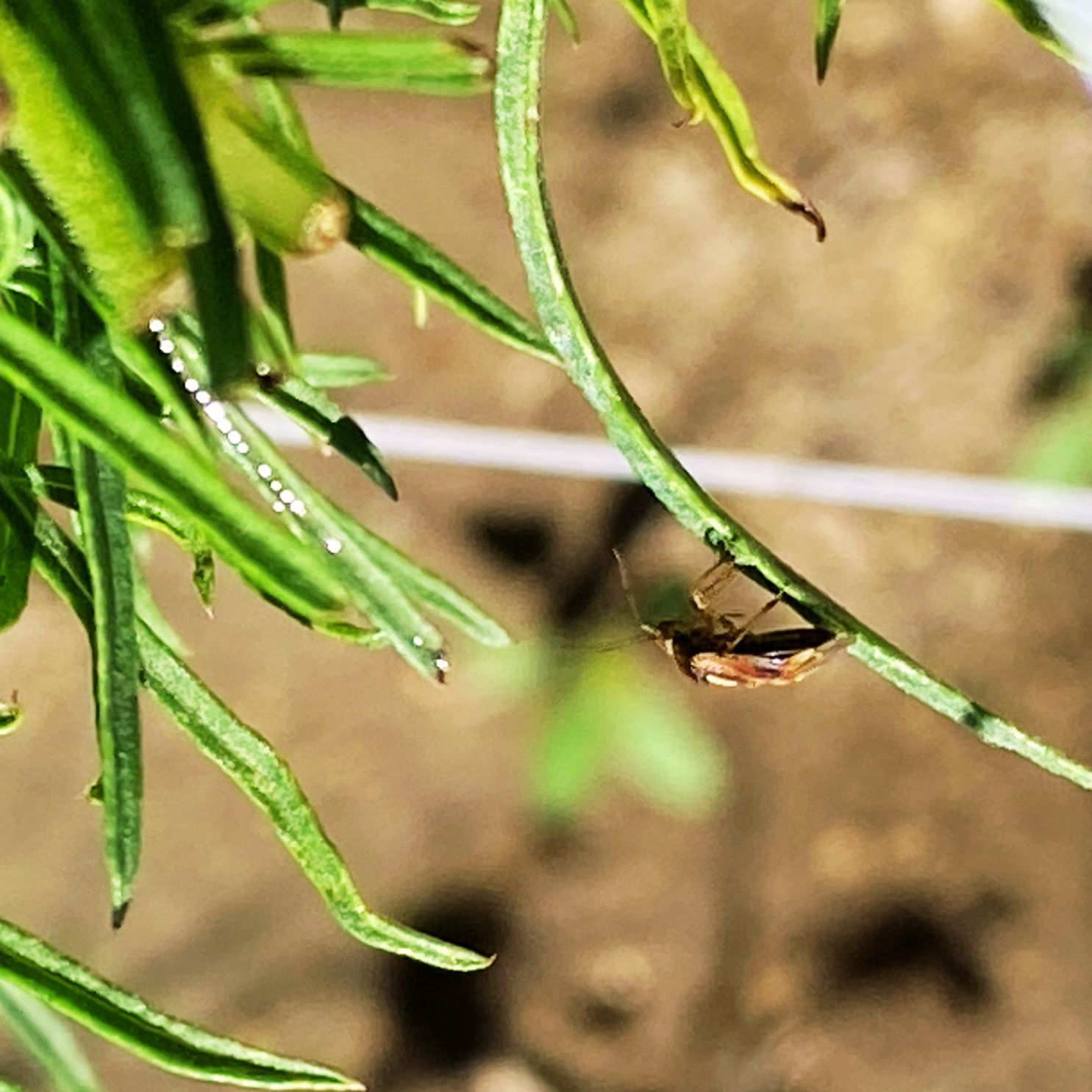Pest Problems in Delphinium and Larkspur Cut Flower Production
 |
 |
In Utah, the popularity of cut flowers is steadily increasing, drawing economic, cultural, and agricultural interest. As of 2023, there are 199 known farms cultivating flowers within the state. Two species, delphinium and larkspur, have gained prominence amongst florists and growers, with 72% of cut flower farmers (n=62) growing them in 2022 . Delphiniums are short-lived perennials, recognized for their tall spikes adorned with densely packed, vibrant, and delicate blossoms in various colors, including unique shades of blue. Larkspur, a closely related annual species, boasts gracefully spikes of airy spurred blossoms in a spectrum of soft colors. As cut flowers, both species are captivating, lending an elegant and dramatic line that provides height and balance to floral arrangements. Nationally, both flowers hold economic significance for the cut flower and potted plant industry. In 2023, the Boston Terminal Market priced one bunch of ten delphinium stems at $17.50-$20.00, and ten bunched larkspur stems at $12.50-$15.00, as provided by the USDA AMS Specialty Crops programs.
Insects and plant diseases present significant threats to the quality and marketability of cut flowers, capable of causing physical damage, reducing aesthetic appeal, and compromising the overall health of floral crops. Both delphinium and larkspur are no exception to pest pressure. Interestingly, both flowers contain high levels of diverse diterpenoid alkaloids, rendering them poisonous to humans and other mammals. Therefore, these flowers are often marketed as deer and rabbit “resistant” for home gardens. Despite their toxicity, various insect species have evolved to feed on delphinium, larkspur, and other poisonous plants, thanks to specialized
digestive tracts working in conjunction with enzymes and other microorganisms.
During summer 2023, Nick Volesky from the USU Extension Integrated Pest Management program/USU Small Farms Lab surveyed delphinium and larkspur grown in research plots at the Utah Agricultural Experiment Station in North Logan for pest activity. Identification was carried out by Volesky and Extension Plant Pathologist, Claudia Nischwitz | USU.
Compilation of insect pests, plant diseases, and other pests observed on delphinium and larkspur at a North Logan research farm in 2023. Pests are ordered by damage severity.
| Species | Description | Management |
|---|---|---|
| Milky slug (Deroceras reticulatum) | Small (20-60mm), land slug with a distinctive translucent and mottled appearance. Common in wet and humid areas, such as high tunnels. Damage includes extensive foliar feeding. | Reduce excess moisture and standing water in production space. Set up copper-based barriers around plants. Place traps and bait products containing iron phosphate or metaldehyde. |
| Powdery mildew (Erysiphe aquilegiae) | White, powdery coating (spores) on the leaves and stems causing reduced photosynthesis, distorted growth, and overall aesthetic degradation of the plants. | Use appropriate plant spacing. Monitor for infection early in the season. Use fungicides containing myclobutanil and sulfur (do not apply sulfur above 90°F). Fungicides may not be effective later in the season. Remove and destroy plant stems after frost. |
| Army cutworm (Euxoa auxiliaris) |
Caterpillar is the general term for the larval stage of moths and butterflies. Size, color, pattern, and life cycle are dependent on the species and instar. Damage severity is correlated to population numbers and host presence. Feeding damage primarily occurs in the foliage, but may extend to other plant parts. | Reduce weed pressure (alternate hosts) in production areas. Handpick and remove larva when spotted. Till or disk soil when not in production to disrupt overwintering life stages. Purchase or encourage natural enemies (predators and parasites) of caterpillar species. Spray for early instars with insecticides containing zeta-cypermethrin, spinosad, Bacillus thuringiensis, permethrin, cyfluthrin, etc. |
| Alfalfa Looper (Autographa californica) | ||
| Cabbage Looper (Trichoplusia ni) | ||
| White-line sphinx moth (Hyles lineata) | ||
| Unspecified larva (Subfamily Heliothinae) | ||
| California tortoiseshell (Nymphalis californica) |
||
| Damping-off (Pythium spp., Phytophthora spp., Rhizoctonia spp., Rhizopus spp., or Fusarium spp.) |
Damping-off is a generalized term describing dieback in transplant greenhouse production caused by various soil-borne fungi. It is characterized by the sudden collapse and decay of seedlings or young plants at or near the soil surface, resulting in rotting stems and impaired plant growth. | Preventative measures include sanitation (using a 10-15% household bleach solution) of growing benches and containers along with sourcing sterile potting mix. Avoid excessive irrigation and standing water. Apply fungicide drenches containing Trichoderma spp. |
| Differential grasshopper (Melanoplus differentialis) |
Grasshoppers are highly mobile and characterized by their large hind legs. Size, color, pattern, and life cycle are dependent on the species and instar. Damage severity is correlated to population numbers and host presence. Feeding damage primarily occurs in the foliage, but may extend to other plant parts. | Manage over a large area due to their high mobility. Bait (wheat bran with carbaryl or Nosema locustae) used by late May/early June is effective, as are insecticides with acephate, beta-cyfluthrin, or bifenthrin. Physical exclusion using insect netting often works best. |
| Two striped grasshopper (M. bivittatus) |
||
| Red legged grasshopper (M. femurrubrum) |
||
| Migratory grasshopper (M. sanguinipes) |
||
| Western flower thrips (Frankliniella occidentalis) |
Very small (1.5mm) slender insects with fringed wings. Plant feeding damage is caused by puncturing and scraping of plant tissue, resulting in silvery scars and distorted growth. | Populations tend to peak in mid-summer, but monitor throughout the season. Scout in the morning when they are often in leaf crevices or blooms. Hand removal or pellets with spinosad are most effective. Other options: containers with bait (soy sauce, oil, etc.) and a perforated lid that are buried up to the lid and emptied periodically. |
| European earwigs (Forficula auricularia) |
Elongated, brown bodies with a prominent pair of rear cerci. Hide in tight and dark spaces on the plant. Damage severity is correlated to population numbers and host presence. Feeding damage primarily occurs in the foliage, but may extend to other plant parts. | Populations tend to peak in mid-summer, but monitor throughout the season. Scout in the morning when they are often in leaf crevices or blooms. Hand removal or pellets with spinosad are most effective. Other options: containers with bait (soy sauce, oil, etc.) and a perforated lid that are buried up to the lid and emptied periodically. |
| Fungus gnat (Superfamily Sciaroidea) |
Very small (3mm) and mosquito-like with long legs and slender bodies. Worm-like larvae consume organic matter in the soil and occasionally damage plant roots and leaves touching the soil surface. Transplant production in the greenhouses is most susceptible. | Trap and monitor fungus gnats and whiteflies by using yellow sticky traps. Ensure proper drainage in soil media trays. Consider purchasing natural predators such as predatory mites, wasps, beetles, etc. Consider insecticides labeled for greenhouse control containing horticultural oils, pyrethrin, azadirachtin, bifenthrin, etc. |
| Greenhouse whitefly (Trialeurodes vaporariorum) |
Very small (1.5mm) and moth-like with white waxy wings and a light-yellow body. Damage is caused by adults and nymphs with their piercing-sucking mouthparts. This causes yellowing, wilting, and the secretion of sticky honeydew on plant surfaces. Transplant production in greenhouses is most susceptible. | |
| Tarnished plant bug (Lygus lineolaris) |
Small true bugs (~6mm), mottled brown with a distinctive triangular shape on their back. Adults and nymphs frequently damage plants by piercing them with their needle-like mouthparts, causing stippling, distortion, and discoloration of plant tissues. | Populations tend to be greatest mid-summer to fall, but monitor throughout the season. Reduce weed pressure (alternate hosts) in production areas. If populations reach damage threshold, consider insecticides containing permethrin, gamma-cyhalothrin, or malathion. |
| Western tarnished plant bug (Lygus hesperus) | ||
| Unspecified leafhopper (Eratoneura spp.) |
Very small (3mm), light-colored leafhopper with intricate patterns on their wings. Infrequent damage caused by adults and nymphs with their piercing-sucking mouthparts causing stippling and yellowing. | Monitor all season, especially during bloom. Reduce weed pressure (alternate hosts) in production areas. If populations reach damage threshold, consider insecticides containing acephate, acetamiprid, bifenthrin, cyfluthrin, deltamethrin, lambda-cyhalothrin, or permethrin. |
| Springtail (Collembola) |
Very small (>5mm) hexapods with a spring-like furcula. Feed on decaying soil organic matter and occasionally create small holes on young seedling cotyledons. | Monitor for seedling damage during cool wet periods. Management is rarely needed. |
 |
 |
 |
|
Additional insect pests, plant diseases, and other pests that can likely cause damage to delphiniums and larkspur in Utah. However, these species were not formally sampled or identified at the research trials conducted in North Logan, UT.
| Species | Description | Management |
|---|---|---|
| Aphids (various unspecified species) | Small, sap-sucking insects, cause damage by piercing and sucking plants, leading to distorted growth, yellowing, and the secretion of honeydew, along with potentially transmitting viruses. | Populations grow rapidly. Encourage or purchase natural predators, such as ladybeetles. Spraying a strong stream of water can dislodge colonies. If populations are at threshold, consider organic insecticides such as insecticidal soaps or horticultural oils. |
| Root-knot nematodes (Meloidogyne spp.) | Root-knot nematodes inflict damage to plants by parasitizing their roots, forming characteristic galls or knots that hinder nutrient uptake, leading to stunted growth, yellowing, and a general decline in the overall health and productivity of the host plant. | Avoid planting in infested area for 2-3 years. Reduce weed pressure (alternate hosts) in production areas. Unless working in a large produce space, soil fumigation is not appropriate. |
| Various fungal diseases that cause wilt, crown rots, stem rots, or root rots (Calophoma aquilegiicola (syn. Diplodina delphinii), Fusarium osysporum. F. delphinii, Diaporthe arctii, etc.) | Soil-borne fungal diseases affecting delphinium and larkspur can impact the stems, crown, roots, and/or other plant parts depending on the species. Symptoms can include wilting, discoloration, and decay ultimately compromising the structural integrity and hinder growth and overall plant health. | These soil-borne diseases are very host specific, prevent introduction of infected soil and plant material. Rotate between host plants. Remove and dispose of all plant residue at a season’s end. Once a plant in infected, it can’t be cured. |
| Various fungal, bacterial, and other parasitic diseases causing leaf spots (Phytomonas delphinii, Calophoma aquilegiicola (syn. Diplodina delphinii), etc.) | Fungal diseases may primarily affect the foliage of delphinium and larkspur primarily affect the foliage. Symptoms can include leaf spotting, browning, and other possible necrosis. These infections can lead to diminished photosynthetic activity, defoliation, and overall aesthetic deterioration in affected plants. | Prevent fungal caused leaf spots by removing dead and infected plant debris from production site. Allow appropriate plant spacing. Consider fungicides or bactericides containing copper ingredients. Ensure proper insect pest management. |
| Bacterial blight (Pectobacterium carotovorum (syn. Erwinia carotovora)) | Bacterial blight causes soft rot symptoms, leading to rapid tissue decay, wilting, and overall structural deterioration in affected plants. | Reduce excess moisture and standing water in production space. Remove dead and infected plant debris from production site. Once a plant in infected, it can’t be cured. |
| Various viruses | Delphiniums are prone to viruses with a broad host range, leading to diverse symptoms such as leaf mottling, mosaic patterns, chlorosis, overall plant stunting, leaf curling, and ring spots; however, since different viruses express similar symptoms, therefore accurate identification requires molecular testing. | Prevent viruses by sourcing virus-free seed or plant stock. Reduce weed pressure (alternate hosts) in production areas. Manage for insects (aphids and thrips) that may vector viruses. Once a plant in infected, it can’t be cured. |
To learn more about pest management in specialty crops, reference fact sheets, videos, and other guides at extension.usu.edu/pests. Additionally, smallfarmslab.com provides resources relating to flower cultivars, optimal planting dates, season extension practices, and sustainable nutrient, soil, and water management. If you need identification of an arthropod or plant disease issue, reach out to the Utah Plant Pest Diagnostic Lab.
• Nick Volesky, Program Associate/Graduate Student
• Claudia Nischwitz, Plant Pathology Specialist
• Melanie Stock, Small/Urban Farms Specialist
From Winter 2024 Utah Pests Newsletter


